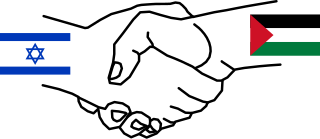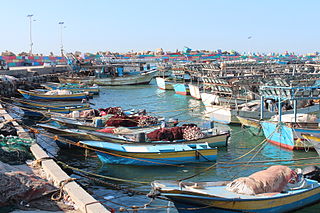Related Research Articles

The Gaza Strip, also known simply as Gaza, is a small, densely populated territory located on the eastern coast of the Mediterranean Sea. It is the smaller of the two Palestinian territories (the other being the West Bank) that comprise the State of Palestine. Gaza is bordered by Egypt on the southwest and Israel on the east and north. The Gaza Strip is administered by Hamas, while the West Bank is primarily governed by the Palestinian Authority (PA), which is dominated by the Fatah party.

Palestine, officially the State of Palestine, is a country in the southern Levant region of West Asia recognized by 145 out of 193 UN member states. It encompasses the Israeli-occupied West Bank and Gaza Strip, collectively known as the Palestinian territories, within the broader geographic and historical Palestine region. The country shares most of its borders with Israel, and it borders Jordan to the east and Egypt to the southwest. It has a total land area of 6,020 square kilometres (2,320 sq mi) while its population exceeds five million people. Its proclaimed capital is Jerusalem, while Ramallah serves as its administrative center. Gaza City was its largest city until 2023.

Sharm El Sheikh, alternatively rendered Sharm el-Sheikh, Sharm el Sheikh, or Sharm El-Sheikh, is an Egyptian city on the southern tip of the Sinai Peninsula, in South Sinai Governorate, on the coastal strip along the Red Sea. Its population is approximately 13,000 as of 2023. Sharm El Sheikh is the administrative hub of Egypt's South Sinai Governorate, which includes the smaller coastal towns of Dahab and Nuweiba as well as the mountainous interior, St. Catherine and Mount Sinai. It was historically a fishing town and military base, and was developed into a commercial and tourist-centric city in 1968 by Israel. Today, the city and holiday resort is a significant centre for tourism in Egypt, while also attracting many international conferences and diplomatic meetings.

The Philadelphi Corridor, also called Philadelphi Route, is the Israeli code name for a narrow strip of land, 14 km in length, situated along the entirety of the border between the Gaza Strip and Egypt.

The Sharm El Sheikh Memorandum, full name: The Sharm El Sheikh Memorandum on Implementation Timeline of Outstanding Commitments of Agreements Signed and the Resumption of Permanent Status Negotiations, was a memorandum signed on September 4, 1999, by Prime Minister of Israel Ehud Barak and PLO Chairman Yasser Arafat at Sharm el Sheikh in Egypt, overseen by the United States represented by Secretary of State Madeleine Albright. The memorandum was witnessed and co-signed by President Hosni Mubarak of Egypt and King Abdullah of Jordan.

This article describes transport in the State of Palestine, which consists of two non-contiguous territories, the West Bank and the Gaza Strip, different parts of which are administered by Palestinian National Authority, Hamas Administration in Gaza and Israel.

The restrictions on movement and goods in Gaza imposed by Israel date to the early 1990s. After Hamas took over in 2007, Israel significantly intensified existing movement restrictions and imposed a complete blockade on the movement of goods and people in and out of the Gaza Strip. Egypt began its blockade of Gaza in 2007, shortly after Hamas took control of the territory. The blockade's current stated aim is to prevent the smuggling of weapons into Gaza; previously stated motivations have included exerting economic pressure on Hamas. Human rights groups have called the blockade illegal and a form of collective punishment, as it restricts the flow of essential goods, contributes to economic hardship, and limits Gazans' freedom of movement. The blockade and its effects have led to the territory being called an "open-air prison".

The Port of Gaza is a small port near the Rimal district of Gaza City, Palestine. It is the home port of Palestinian fishing-boats and the base of the Palestinian Naval Police, a branch of the Palestinian National Security Forces. Under the Oslo II Accord, the activities of the Palestinian Naval Police are restricted to 6 nautical miles from the coast. Since 2007, the Port of Gaza has been under an Israeli-imposed naval blockade as part of a blockade of the Gaza Strip, and activities at the port have been restricted to small-scale fishing.
The Protocol on Economic Relations, also called the Paris Protocol, was an agreement between Israel and the PLO, signed on 29 April 1994, and incorporated with minor amendments into the Oslo II Accord of September 1995.

Tourism in the Palestinian territories is tourism in East Jerusalem, the West Bank, and the Gaza Strip. In 2010, 4.6 million people visited the Palestinian territories, compared to 2.6 million in 2009. Of that number, 2.2 million were foreign tourists while 2.7 million were domestic. In the last quarter of 2012 over 150,000 guests stayed in West Bank hotels; 40% were European and 9% were from the United States and Canada. Major travel guides write that "the West Bank is not the easiest place in which to travel but the effort is richly rewarded."
Events in the year 2010 in the Palestinian territories.
Events in the year 2007 in the Palestinian territories.

Egypt–Palestine relations are the bilateral relations between the Arab Republic of Egypt and the State of Palestine. Egyptian President Gamal Abdel Nasser was a strong supporter of the Palestinian cause and he favored self-determination for the Palestinians. Although the Egyptian government has maintained a good relationship with Israel since the Camp David Accords, most Egyptians strongly resent Israel, and disapprove of the close relationship between the Israeli and Egyptian governments.

The Oslo Accords are a pair of interim agreements between Israel and the Palestine Liberation Organization (PLO): the Oslo I Accord, signed in Washington, D.C., in 1993; and the Oslo II Accord, signed in Taba, Egypt, in 1995. They marked the start of the Oslo process, a peace process aimed at achieving a peace treaty based on Resolution 242 and Resolution 338 of the United Nations Security Council. The Oslo process began after secret negotiations in Oslo, Norway, resulting in both the recognition of Israel by the PLO and the recognition by Israel of the PLO as the representative of the Palestinian people and as a partner in bilateral negotiations.

Hamas has governed the Gaza Strip in Palestine since its takeover of the region from rival party Fatah in June 2007. Hamas' government was led by Ismail Haniyeh from 2007 until February 2017, when Haniyeh was replaced as leader of Hamas in the Gaza Strip by Yahya Sinwar. As of November 2023, Yahya Sinwar continues to be the leader of Hamas in the Gaza Strip. In January 2024, due to the ongoing Israel–Hamas war, Israel said that Hamas lost control of most of the northern part of the Gaza Strip. In May 2024, Hamas regrouped in the north.

Restrictions on the movement of Palestinians in the Israeli-occupied territories by Israel is an issue in the Israeli–Palestinian conflict. According to B'Tselem, following the 1967 war, the occupied territories were proclaimed closed military zones. In 1972, general exit orders were issued allowing residents of those territories to move freely between the West Bank, Israel and the Gaza Strip. Following the First Intifada by 1991, the general exit orders were revoked, and personal exit permits were required. According to B'Tselem, a measure of overall closure of the territories was enacted for the first time in 1993, and would result in total closures following rises in Palestinian political violence.

The Agreement on Movement and Access (AMA) was an agreement between Israel and the Palestinian Authority (PA) signed on 15 November 2005 aimed at improving Palestinian freedom of movement and economic activity within the Palestinian territories, and open the Rafah Crossing on the Gaza–Egypt border. AMA was described as: ″an agreement on facilitating the movement of people and goods within the Palestinian Territories and on opening an international crossing on the Gaza-Egypt border that will put the Palestinians in control of the entry and exit of people.″ Part of the agreement was the Agreed Principles for Rafah Crossing.

Palestine produces no oil or natural gas and is predominantly dependent on the Israel Electric Corporation (IEC) for electricity. According to UNCTAD, the Palestinian Territory "lies above sizeable reservoirs of oil and natural gas wealth" but "occupation continues to prevent Palestinians from developing their energy fields so as to exploit and benefit from such assets." In 2012, electricity available in West Bank and Gaza was 5,370 GW-hour, while the annual per capita consumption of electricity was 950 kWh. National sources only produce 445 GWh of electricity, supplying less than 10% of demand. The only domestic source of energy is the disputed Gaza Marine gas field, which has not yet been developed. Palestinian energy demand increased rapidly, increasing by 6.4% annually between 1999 and 2005. Future consumption of electricity is expected to reach 8,400 GWh by 2020 on the expectation that consumption will increase by 6% annually.
The Gaza Development Plan is a proposed plan put forward by the Israeli Prime Minister Naftali Bennett and Israeli Foreign Minister Yair Lapid in September 2021 with the intent to mediate an end to the Gaza–Israel conflict. The plan promises to repair the Gazan standard of living and help construct new Gazan infrastructure.

The Gaza floating pier was a floating dock facility created by the U.S. military after being proposed immediately before U.S. President Biden's 2024 State of the Union Address on March 7, 2024. It was in use between May and July 2024.
References
- ↑ Agreed documents by Israel and Palestinians on Movement and Access from and to Gaza Archived 4 October 2013 at the Wayback Machine . "Agreement on Movement and Access" and "Agreed Principles for Rafah Crossing", 15 November 2005
- ↑ Declaration of Principles on Interim Self-Government Arrangements (DOP), Annex III, Art. 5. 13 September 1993. From the Knesset website
- ↑ Gaza-Jericho Agreement, Annex I, Article XI
- ↑ Sharm el-Sheikh Memorandum, Art. 6. 4 September 1999
- ↑ Palestinian territories – Review of the Netherlands development programme for the Palestinian territories, 1994-1999 Archived 31 October 2022 at the Wayback Machine , IOB-evaluation no. 282, pp. 32, 34, 37-38. Policy and Operations Evaluation Department (IOB) of the Dutch Ministry of Foreign Affairs, November 1999
- ↑ "Power Point Presentation of the project" (PDF). Archived from the original (PDF) on 31 July 2020. Retrieved 6 February 2014.
- ↑ Freedom of movement a year after disengagement Archived 5 September 2022 at the Wayback Machine . IMEU, 16 August 2006
- ↑ Gaza Commercial Seaport Archived 3 November 2022 at the Wayback Machine . University Gent (Belgium), May 2013. Power Point
- ↑ One Big Prison—Freedom of Movement to and from theGaza Strip on the Eve of the Disengagement Plan, p. 60. HaMoked and B’Tselem, March 2005. Summary on UNISPAL
- 1 2 Israel may build artificial island off Gaza Strip coast. Conal Urquhart, The Guardian, 30 March 2011
- 1 2 Israel planning to build island off Gaza Strip for port. Agence France-Presse (The National), 31 March 2011
- ↑ PA plans airport in West Bank, seaport and railway in Gaza.Ma'an News, 10 February 2014
- ↑ Palestinians plan airports in West Bank, seaport and railway in Gaza. Haaretz, 10 February 2014
- ↑ Ward, Alexander (7 March 2024). "Biden to order US military to construct port in Gaza to increase aid flow". POLITICO. Retrieved 7 March 2024.
- ↑ Magdy, Samy; Sewell, Abby; Madhani, Aamer; Knickmeyer, Ellen (8 March 2024). "Biden orders US military to set up temporary aid port for Gaza as famine threatens". Associated Press. Retrieved 3 April 2024.
- ↑ Debusmann, Bernd (13 March 2024). "How the US military plans to construct a pier and get food into Gaza". BBC News. Retrieved 3 April 2024.